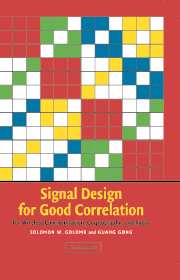Book contents
- Frontmatter
- Contents
- Preface
- Acknowledgments
- Historical Introduction
- 1 General Properties of Correlation
- 2 Applications of Correlation to the Communication of Information
- 3 Finite Fields
- 4 Feedback Shift Register Sequences
- 5 Randomness Measurements and m-Sequences
- 6 Transforms of Sequences and Functions
- 7 Cyclic Difference Sets and Binary Sequences with Two-Level Autocorrelation
- 8 Cyclic Hadamard Sequences, Part 1
- 9 Cyclic Hadamard Sequences, Part 2
- 10 Signal Sets with Low Crosscorrelation
- 11 Correlation of Boolean Functions
- 12 Applications to Radar, Sonar, Synchronization, and CDMA
- Bibliography
- Index
9 - Cyclic Hadamard Sequences, Part 2
Published online by Cambridge University Press: 15 August 2009
- Frontmatter
- Contents
- Preface
- Acknowledgments
- Historical Introduction
- 1 General Properties of Correlation
- 2 Applications of Correlation to the Communication of Information
- 3 Finite Fields
- 4 Feedback Shift Register Sequences
- 5 Randomness Measurements and m-Sequences
- 6 Transforms of Sequences and Functions
- 7 Cyclic Difference Sets and Binary Sequences with Two-Level Autocorrelation
- 8 Cyclic Hadamard Sequences, Part 1
- 9 Cyclic Hadamard Sequences, Part 2
- 10 Signal Sets with Low Crosscorrelation
- 11 Correlation of Boolean Functions
- 12 Applications to Radar, Sonar, Synchronization, and CDMA
- Bibliography
- Index
Summary
Before 1997, only two essentially different constructions that were not based on a number theory approach were known for cyclic Hadamard difference sets with parameter (2n − 1, 2n−1 − 1, 2n−2 − 1) or, equivalently, for binary 2-level autocorrelation sequences of period 2n − 1 for arbitrary n. One is the Singer construction, which gives m-sequences, and the other is the GMW construction, which produces four types of GMW sequences. Exhaustive searches had been done for n = 7, 8, and 9 in 1971, 1983, and 1992, respectively. However, there was no explanation for several of the sequences found for these lengths that did not follow from then-known constructions. In this chapter, we will describe the remarkable progress in finding new constructions for 2-level autocorrelation sequences of period 2n − 1 since 1997. (An exhaustive search was also done for n = 10 in 1998.) The order of presentation of these remarkable constructions will follow the history of the developments of this research. Section 9.1 presents constructions of 2-level autocorrelation sequences having multiple trace terms. In Section 9.2, the hyper-oval constructions are introduced. Section 9.3 shows the Kasami power construction. In the last section, we introduce the iterative decimation-Hadamard transform, a method of searching for new sequences with 2-level autocorrelation.
Multiple trace term sequences
In this section, we present 3-term sequences, 5-term sequences, and the Welch-Gong transformation sequences.
- Type
- Chapter
- Information
- Signal Design for Good CorrelationFor Wireless Communication, Cryptography, and Radar, pp. 267 - 322Publisher: Cambridge University PressPrint publication year: 2005



